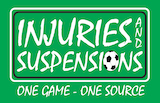This weekend in Serie A was the most challenging for VAR since its introduction in Italy. It wasn’t just the number of mistakes but the variety of them that left people wondering what’s the point.
In Naples, Roberto Donadoni cried conspiracy. “It’s like living on another planet,” he complained. “Some penalties don’t get given to teams in eighth place or below. But they do for the teams above.”
The Bologna manager was aggrieved that referee Paolo Mazzoleni chose not to review a handball by Napoli centre-back Kalidou Koulibaly. At a ‘masterclass’ arranged over the winter break by the FIGC and Italian Refereeing Association, clubs were reassured that, from now on, the referee would go to the monitor for all such incidents. Mazzoleni clearly didn’t get the memo. Nor did he help his case by then awarding Napoli a soft penalty and the chance to get back into a game they had been trailing.
Worse was to come in Puglia, where the referee Paolo Tagliavento did elect to use the sideline review to check his own decisions. The problem was, even with the assistance of a series of replays, he still made mistakes.
First he awarded Crotone a soft penalty. Then, a short while later, he gave Cagliari defender Fabio Pisacane his marching orders. As a straight red the VAR could invite Tagliavento to review his decision, an invitation he duly accepted. From the pictures, it was clear Pisacane had been harshly done by and a yellow would have been sufficient. But Tagliavento stood by the call and sent him down the tunnel for an early bath.
The Cagliari bench was incensed. In the end, though, they still managed to avoid defeat thanks to another calamitous refereeing error. This time it was the fault of linesman Andrea Crispo. He flagged for offside just as Crotone scored what should have been a late winner. Federico Ceccherini wasn’t ahead of the ball when it was played, though. Nor were any of his teammates. But Crispo thought otherwise.
VAR should have ensured justice was done. Tagliavento again trotted over to the screen. But what was obvious to everyone wasn’t to him. In his opinion Crispo had been spot on. Walter Zenga, the Crotone manager, was incredulous. “It makes me laugh,” he said. “The only explanation I can think of is that maybe they were confused by the colours.” Did Tagliavento suddenly think Crotone, and not Cagliari, were playing in white?
The evening game did not pass without incident either. It had its own Hand of God moment. The opening goal at San Siro was a handball. Admittedly very difficult to see in real-time, the young Milan striker Patrick Cutrone scored with the top of his arm not his head. The reason it stood was no fault of the referee Max Irrati. Even at the monitor he never got to see it.
The production company supplied the VAR with the replays, which in turn were shown to Irrati did not identify a conclusive one quick enough. And so the three Irrati saw left him none the wiser. “It’s incredible,” Simone Inzaghi grimaced. “They’re going to have to explain this. It’s a shame. But yet again we’ll try to understand even if the images speak for themselves.”
Inzaghi’s bitterness stems from other VAR cock-ups, particularly in December when, in his opinion, they cost Lazio points against Torino and Fiorentina. If the Biancocelesti had won those games, we might have been talking about a three-way fight for the title, instead of just a two-horse race.
Win cash prizes for free with our competition!
| User |
Total tips |
Profit | 1 | Yield | Expected prize |
|
|
30
|
455535 | 2 |
+19.56%
|
500 EUR |
 unhoose
unhoose
|
32
|
304586 | 3 |
+21.86%
|
250 EUR |
 Alchemist
Alchemist
|
28
|
258362 | 4 |
+23.75%
|
125 EUR |
|
|
18
|
196442 | 5 |
+17.95%
|
75 EUR |
|
|
9
|
146478 | 6 |
+30.61%
|
50 EUR |
Don't miss out - join our January Tipster Competition today
In their own review the talk shows and papers settled on the same headline for the lead story of the weekend. Domenica Nera. A Black Sunday for VAR. “Lads, it’s over. VAR has failed,” the former Juventus and Napoli midfielder, Massimo Mauro said on Sky Calcio Club. “Let’s get rid of it and go back to where we were before when it was much better.” The good old days. “I liked the mistake in the Milan game,” he added. “It’s part of the game.”
Mauro wasn’t alone. In La Stampa, the venerable Gigi Garanzini wrote in reference to Cutrone’s own spin on El Diego’s Mano de Dios: “What kind of tool is this if you can see he scored with his hand and not with his head only after the 10th or 15th replay. What’s the hurry to have a revolution when the technology is not ready?”
The outrage is only going to intensify as the end of the season approaches and the stakes get higher. Zenga had the good grace to “accept” the result against Cagliari, but those two points dropped against a rival for survival could have a big impact on whether Crotone stay up or not.
Amid all the uproar, the successes of this live experiment with VAR are easily drowned out. The statistics supplied at the masterclass a fortnight ago put forward a convincing case that VAR is changing football for the better in Italy. Of 1078 decisions taken in the first half of the season, 60 were corrected, 49 mistakes were avoided and only 11 were made. That’s 1%, which is considerably down on the same stage last year when it was as ‘high’ as 5.6%.
Breaks in play remain the biggest concern. They suck the emotion and the drama out of the game. But, on average, it is now taking just 29 seconds to come to a decision - an improvement on the 1’22” it was taking in the first three weeks of the season. When a review is deemed necessary the average is also down from 2’35” to 1’15”. But it can feel a lot longer. And patience with referees to make the right call is in shorter supply than ever now they have access to replays.
The unseen benefits get much less publicity. Penalties are up 5.5% despite what happened to Bologna at the weekend. Players are getting away with less. And because of that they are also thinking twice about doing anything reckless.
Fouls are down 8%, yellow cards 18.8% and diving 23%. VAR is cleaning up the game. Fewer fouls might lead to fewer injuries, less dangerous play. Fewer yellows result in fewer suspensions. Which should mean a better standard of competition because the best players are neither in the treatment room, nor on the stand in disciplinary hearings. Effective time is also up on average by 40 seconds. Granted that’s not a lot, but we are getting to see a little more football.
There will be bad days like Sunday and it’s hard to escape that feeling the game is now more complicated than it should be. “It’s harder to be a football fan today than it was 10 years ago,” mused Esteban Cambiasso, “Before you just needed to know the rules of the game and supported your team. Now you have to know the rules of the game, the rules for VAR and FFP… Madonna!”
For all the calls of VARfanculo, it’s imperative to keep in mind that this is still a live experiment. Getting used to it takes time. The intentions are noble and notwithstanding all the criticism VAR is coming under that sentiment remains widely shared. People want it to be a success in Italy in part because the powers that be feel they have taken the lead in adopting it. Often portrayed as a league that’s been left behind this is an opportunity to be seen as the vanguard. A model to follow.
The biggest task, though, remains not so much in getting as many decisions correct as possible, but making a convincing enough case that a work in progress which is occasionally in the wrong is still very much the right thing for the future. “There’s no going back,” insists Nicola Rizzoli, the head of Italy’s refereeing association.















